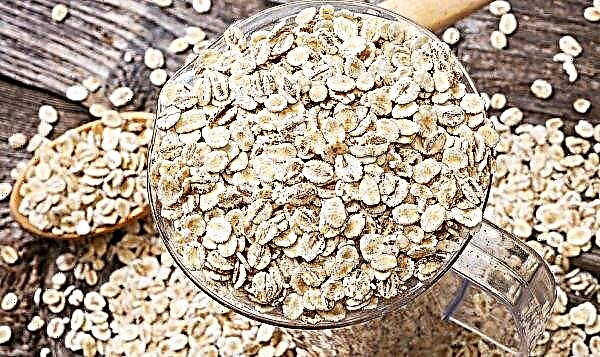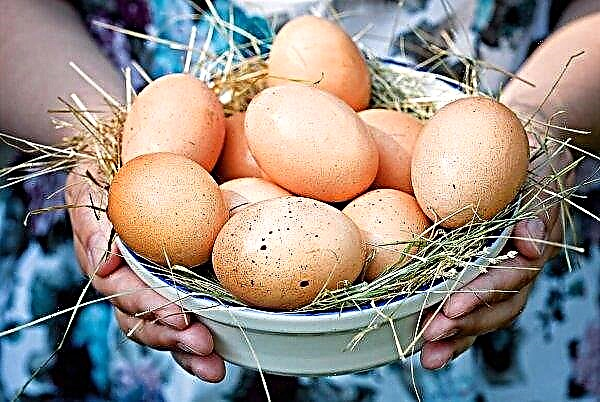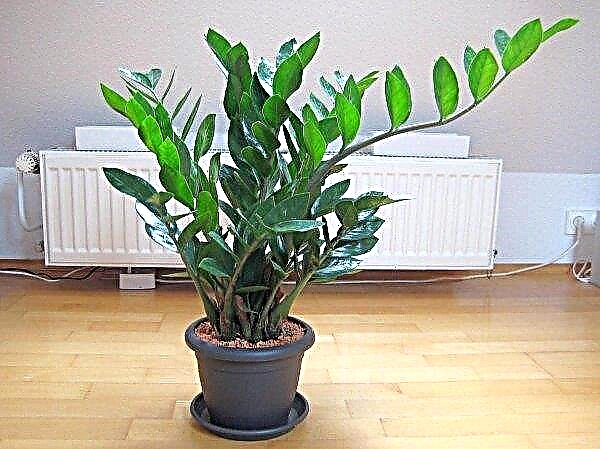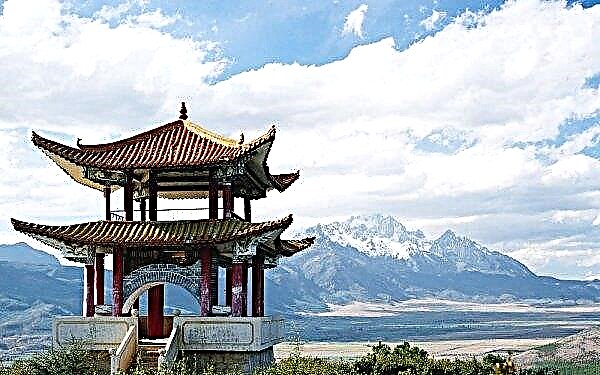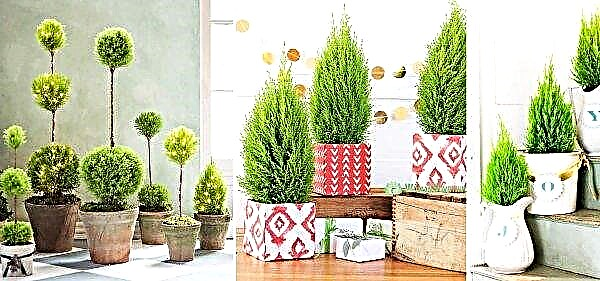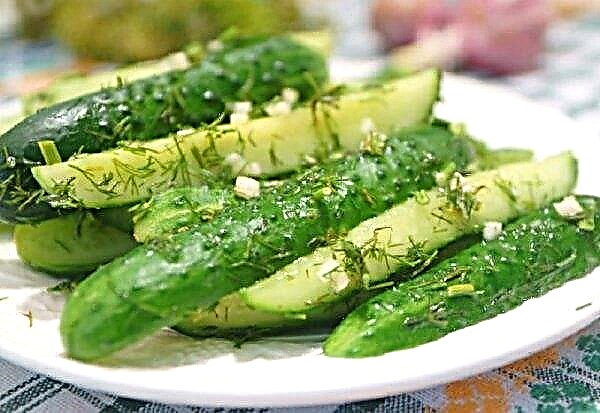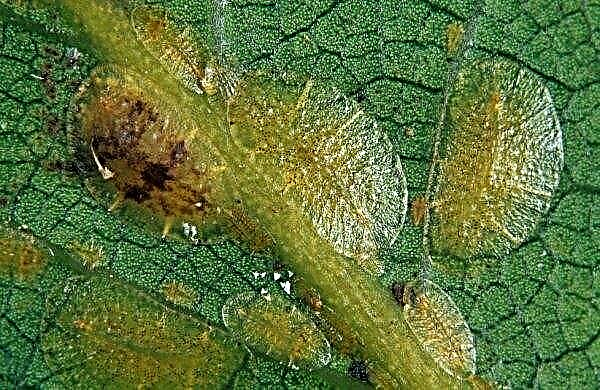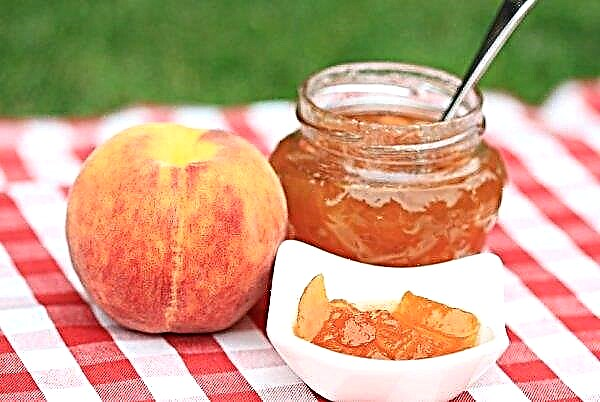Coniferous trees and shrubs are an indispensable decoration of any site. One of the most striking and popular representatives of ornamental plants can be called juniper rocky Blue Arrow (Blue Arrow). It has a perfect evergreen appearance and shape. Later in the article you will learn about it in more detail.
Botanical Description
This plant is one of the varieties of virgin junipers. It has an arrow-shaped shape. The advantage of the appearance of the crown is that with age it does not lose its beauty. After the winter period and heavy snowfalls it also looks good. The length of vertically directed branches reaches 2 meters, since they are stored on a tree for a long period. The structure is rigid and scaly.
The length of vertically directed branches reaches 2 meters, since they are stored on a tree for a long period. The structure is rigid and scaly.
At the age of ten, a tree can reach 2.5 m in height and 70 cm in width. It has a fairly miniature size due to the narrow diameter. The growth rate is average: for a year, juniper grows by about 15 cm. The maximum height of the plant can be 5 m.
The color of the needles stands out against the background of all the inhabitants of the garden, since it is blue, sometimes blue. Due to this feature of juniper it is called the Blue Arrow (English Blue Arrow). Cones of the same color as needles grow on a tree.Did you know? Our ancestors made dishes from juniper. In a container of such wood products were stored for a long time and milk did not sour.
Video: Juniper Blue Arrow
Differences from Juniper Skyrocket
Junipers Skyrocket (Sky Rocket) and Blue Arrow are very similar to each other. Inexperienced gardeners can easily confuse them. But if you look closely, you can see that in the first grade the crown is more magnificent, and the dimensions of an adult tree are much larger. In recent years, landscape designers have often preferred Blue Arrow, since it looks spectacular, while being compact and does not require much space.
Landing
The first thing you need to familiarize yourself with in order to successfully grow this plant near your home is the rules for planting.
Seedling preparation
It is best if you buy a seedling in a trusted nursery or specialty store, since the planting material will be in a container that is good protection for the root system from various damage. It also allows the plant to quickly acclimatize and take root in a new place. 
If the seedling is not in a closed container, then there is a great risk of damaging the roots. You need to be very careful with them. Before planting, be sure to treat them with a root stimulant (“Kornevin” or “Radifarm”).
Important! It is recommended to plant the plant in question in the spring, so that it has time to get stronger before the onset of winter.
Site selection and preparation
Before buying a seedling, you need to decide on the place where the juniper will grow. Prefer the closed area: strong winds can damage young shoots, which will affect the appearance of the tree. The rocky variety Blue Arrow prefers lighted areas. In the shade, the juniper grows dull and grows more slowly.

The soil on the site should be drained and not very fertile. Also note that the tree does not like sour soil. If the land is just such, then before planting it is necessary to make liming (300 g of lime per 1 m²). Remove weeds in the area and dig the land well.
Landing process
The landing process has the following steps:
- Pit preparation. A hole is dug 2-3 times wider than an earthen lump of seedling. The optimal depth is 80 cm.
- Drainage. At the bottom of the landing pit, lay a 7 cm layer of broken brick.
- Preparation of the soil mixture. You need to mix in a ratio of 2: 1: 1 peat, sheet land and sand. Also add complex mineral fertilizer for needles (60 g), which can be bought at any specialized store.
- Juniper planting. In the pit, you need to immerse the seedling and cover it with soil prepared in advance, without the need to fill the root neck - it should remain at the soil level.
- Watering. Seat plenty of water should be watered (2 buckets).
- Mulching. To preserve moisture, the periostemal circle should be covered with a small layer (6-7 cm) of a mixture of pine chips and bark.

Juniper Care
Juniper rocky Blue Arrow is an unpretentious plant: caring for it will not bring you any difficulties. Standard procedures, which will be discussed in detail later, will create favorable conditions for tree growth.
Important! All varieties of this crop adore spraying. It is better to carry out the procedure in the evening so that the moisture does not evaporate as long as possible and the tree can absorb it.
Watering
A feature of the root system of this variety is its compactness. Because of this, she is not able to independently receive the necessary substances and moisture from the soil. Water the tree 2 times a week, and in the first year after planting - every 2 days.

Top dressing
The plant in question must be fertilized periodically if you want to see a healthy and beautiful tree on your site. In the spring, under each juniper make about 40 g of special complex fertilizers for conifers. In the autumn period, potassium-phosphorus top dressing is excellent - 100 g of the product is scattered around the tree trunk.
Loosening and mulching
The soil near young plants must be loosened several times during the season. At the same time, the earth is processed superficially so as not to damage the root system. An adult tree does not need this process.
Mulching is also necessary in the first year after planting. This allows you to retain moisture, which is necessary for the plant to take root. Suitable material is straw, bark, pine chips. Mulching also helps fight weeds.
Pruning
Tree pruning is carried out in early spring. You need to cut the juniper before the sap flow begins. Do not cut the branches much - this can adversely affect the plant. It is recommended to remove no more than 1/3 of the length.
Immediately after the procedure, the juniper must be treated with fungicides so that various infections do not affect the places of the slices. Also, this will allow the branches to grow evenly in the future.
Winter preparations
Junipers are winter-hardy plants. But it’s better to shelter young trees for preventive purposes. For this you need to prepare agrofibre.
Immediately after the soil thaws in the spring, the material can be removed. The procedure is recommended on a cloudy day, so that the plant adapts to sunlight.
Possible pests and diseases
Most often, the rocky juniper Blue Arrow is struck by rust. Infected twigs must be removed immediately and the tree treated with a fungicide. After 10 days, the procedure should be repeated.
Did you know? Dream Interpretations say: if in a dream you see juniper, then in real life you will find luck and wealth.
Pests can also damage junipers. The needles are struck by their representatives:
- Aphid. “Fitoverm” will help to destroy the insect (4 g of the product per 2 liters of water). After 2 weeks, the tree needs to be reprocessed.
- Mining Moth. To get rid of this pest, you need to use "Decis" (3 g of the drug per 15 liters of water). For prevention, repeat treatment after 2 weeks.
- Spider mite. In this case, the Karate remedy will help (75 g of the drug per 15 liters of water).
- Shield. Effectively destroys the pest solution "Arcerida" (75 g of the product in 15 liters of water). Processing must be done several times repeatedly with an interval of about 2 weeks.

Breeding methods
The described species of juniper gardeners, as a rule, propagated by a vegetative method - cuttings with semi-lignified shoots. A suitable period for the procedure is the beginning of spring. The survival rate of seedlings is high - about 70%. The main thing during reproduction is not to violate the time frame and process planting material with a growth stimulator.
The seed method is also possible for cultivation, but it is used extremely rarely. This process has been delayed for more than one year, because in order for a seedling to grow from seeds, you need to wait about 3 years.
Use in landscape design
Blue Arrow is an ideal plant for decorating personal plots. Its main advantage is a beautiful crown, which has a stable character and does not need additional formation.
Also a feature of this juniper can be called the color of the needles. Thanks to this, the plant stands out and often becomes the main element in the landscape design of the site. The tree looks great in both group and single compositions. 
This juniper variety is often seen in terraces and balconies. The plant is in special containers and creates a special atmosphere.
The variety of junipers is striking - these beautiful plants are able to harmoniously decorate any site. The Blue Arrow variety has several advantages among all types of culture: its color and shape do not leave anyone indifferent.

